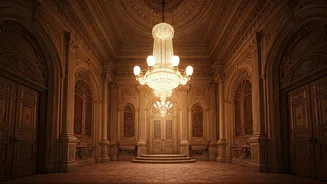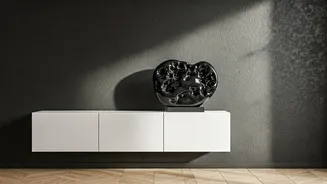Architectural Inspirations Revealed
The allure of constructing extravagant spaces, such as gold ballrooms, naturally triggers questions regarding the architectural influences at play. While
the initial focus often centers on the financial aspect of such projects, a deeper examination reveals a tapestry woven with cultural preferences, historical echoes, and artistic expressions. For instance, the use of gold, historically associated with wealth and power, might suggest an attempt to evoke feelings of grandeur. Analyzing the intricacies of such designs, from the selection of materials to the spatial arrangement, provides insight into the intentions of the designers and the values they aim to convey. Different cultures have different preferences when it comes to expressing their affluence. Therefore, these spaces could be seen as an attempt to appeal to a certain section of the public and showcase cultural influences.
India’s Construction Playbook
India's rich architectural heritage often features elaborate detailing, extensive use of precious materials, and a commitment to creating aesthetically pleasing environments. In Indian construction, the incorporation of symbolic elements, intricate carvings, and the blending of different design styles are common. The presence of these can be seen in various historical structures. These elements not only contribute to visual appeal but also reflect the cultural significance and historical narratives of the region. This is in contrast to the more minimalist styles sometimes seen in Western construction. Considering this, a design that incorporates gold and elaborate ornamentation might draw inspiration from these long-standing aesthetic traditions and could aim to project an image of power and luxury. There may be a possible exchange of ideas in the construction space, where global influences intermingle with local design strategies.
The Significance of Design
Beyond aesthetics, architectural choices can speak volumes about values, beliefs, and aspirations. The meticulous selection of materials, color palettes, and spatial arrangements forms a silent language that communicates messages to the occupants and observers. In any construction endeavor, the careful consideration of the cultural context is very important. Architectural details are essential for influencing the perceptions and expectations of those who interact with the space. For example, a gold ballroom, with its emphasis on opulence and grandeur, sends a very different message compared to a space designed with simplicity and minimalism. These differences reflect the distinct cultural viewpoints and artistic preferences. They offer insights into the motivations driving the creation of such elaborate environments.
Motivations Behind Opulence
Creating spaces of such luxury, like the gold ballroom, typically involves multiple motivations. Highlighting prestige and power is an apparent goal, aiming to impress visitors and project an image of wealth and control. Beyond this, these kinds of projects sometimes fulfill an artistic vision, seeking to celebrate beauty and artistic expression. The construction of luxurious spaces might serve as a means to express cultural identity. It may highlight a sense of pride in history, reflecting the unique character of that particular place or culture. It often represents a desire to showcase accomplishments, or commemorate important moments. This kind of construction showcases the intentions of the creators and the wider ambitions of the society. Thus, exploring the motivations provides a deeper understanding of the significance of these elaborate spaces.














